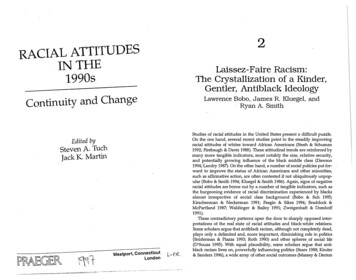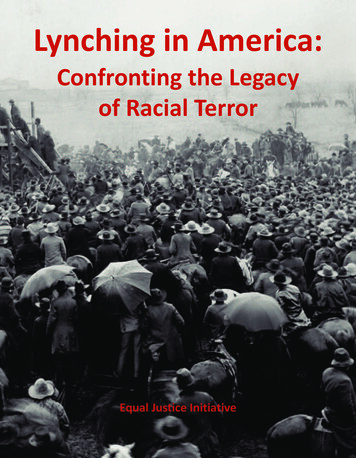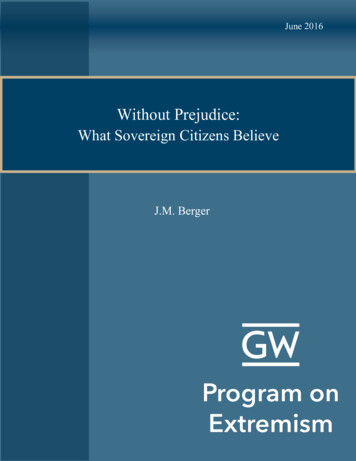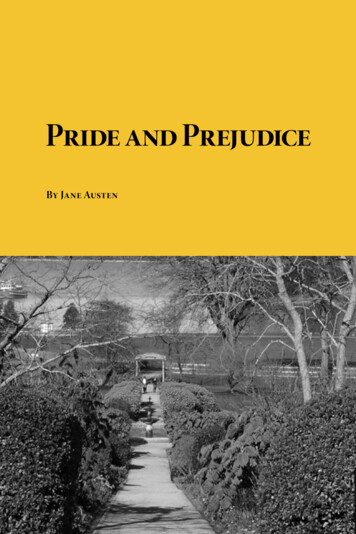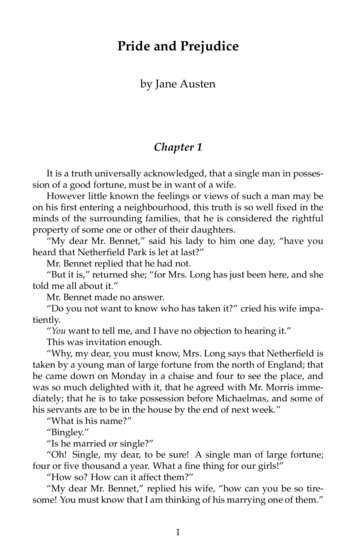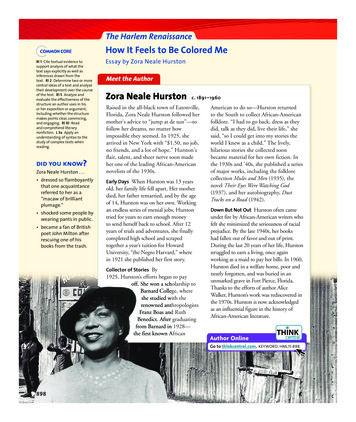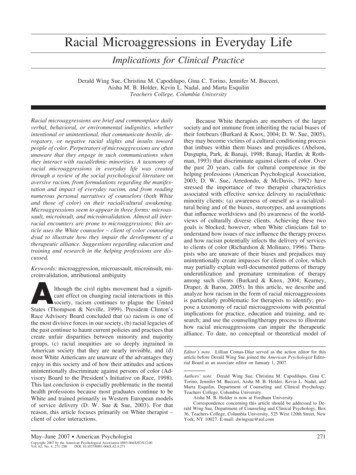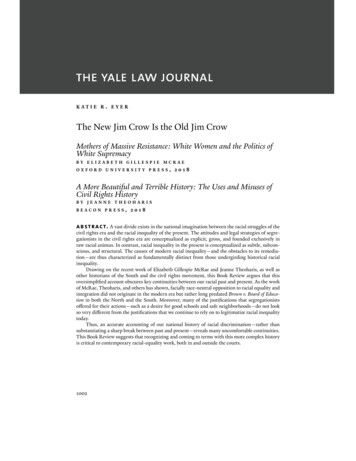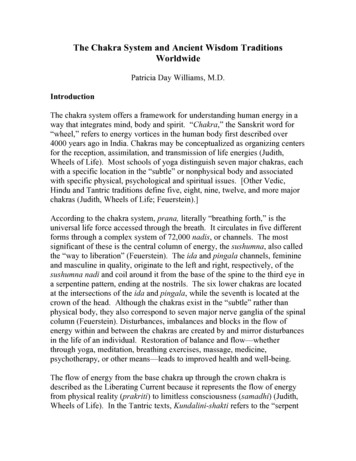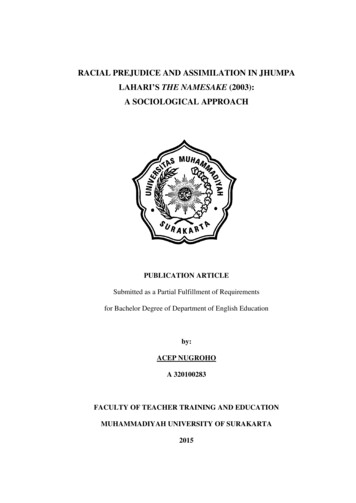
Transcription
RACIAL PREJUDICE AND ASSIMILATION IN JHUMPALAHARI’S THE NAMESAKE (2003):A SOCIOLOGICAL APPROACHPUBLICATION ARTICLESubmitted as a Partial Fulfillment of Requirementsfor Bachelor Degree of Department of English Educationby:ACEP NUGROHOA 320100283FACULTY OF TEACHER TRAINING AND EDUCATIONMUHAMMADIYAH UNIVERSITY OF SURAKARTA2015
RACIAL PREJUDICE AND ASSIMILATION IN JHUMPALAHARI’S THE NAMESAKE (2003):A SOCIOLOGICAL APPROACHACEP NUGROHOA 320100283School of Teacher Training and EducationMuhammadiyah University of Surakartaangorbachev99@gmail.comAbstractThis study is about racial prejudice and assimilation. The problem of thisstudy is racial prejudice and assimilation is reflected in Jhumpa Lahiri’s TheNamesake. The object of the study is The Namesake novel by Jhumpa Lahiri. Itused sociological approach. This study belongs to qualitative research. In thismethod, there are two types of data source, namely primary and secondary datasource. The primary data source is The Namesake novel and the secondary datasource is other material related to the study. Both data are collected throughlibrary research and analyzed by descriptive analysis. The result of the studyshows the following conclusion. Based on the analysis it is clear that there is aclose relation between structural analysis of this novel and social reality inAmerica in early twenty first century. Jhumpa Lahiri wants to show the racialprejudice and assimilation in America in the early twenty first century throughThe Namesake novel.Keyword: racial, prejudice, assimilation, America, The Namesake, Sociological.
A. IntroductionThe Namesake is a novel by Jhumpa Lahiri. Which was published in 2003by a mariner book Houghton Mifflin company, Boston, New York . There are 12chapters and 289 pages in this novel. It is printed in the United States ofAmerica.It was originally a novella published in The New Yorker and was laterexpanded to a full length novel. It explores many of the same emotional andcultural themes as her Pulitzer Prize-winning short story collection Interpreter ofMaladies.The author of this novel is Jhumpa Lahiri. She was born in NilanjanaSudeshna to Bengali Indian immigrants in London. Jhumpa Lahiri moved with herfamily to the United States when she was three years old. She grew up inKingston, Rhode Island and earned a B.A. in English literature from BarnardCollege in 1989. She went on to earn an M.A. in English, an M.F.A. in CreativeWriting, an M.A. in Comparative Literature, and a Ph.D. in Renaissance Studiesfrom Boston University. From 1997-1998, she held a fellowship at Provincetown'sFine Arts Work Center. Lahiri married journalist Alberto Vourvoulias-Bush in2001. They had two children: Octavio in 2002 and Noor in 2005. The familycurrently lives in Brooklyn, New York.In 2003, Lahiri followed up with The Namesake, a novel that followed thelives, perspectives and changing family ties of the Gangulis, an Indian couple inan arranged marriage who relocate to America. The work was adapted into a 2007Mira Nair film starring Irfan Khan and Tabu, with Lahiri acknowledging that shefelt a connection to the director's sensibilities.1
Lahiri returned to the short-story form via her next literary outing, 2008'sUnaccustomed Earth, with the title take from an introductory passage found inNathaniel Hawthorne's Scarlet Letter. With prose focusing on the lives ofimmigrant clans and U.S.-raised children, including a linked trio of tales at book'send, Unaccustomed Earth reached No. 1 on The New York Times' best-seller list.There are some researchers who prevoiusly conducted different studies ofJhumpa Lahiri’s The Namesake. Among the lists are “Conflicts Of CulturalValues Reflected In Jhumpa Lahiri’s The Namesake: A Sociological Study OfLiterature” by Erwin Dwi Nurpermadi (2013). “Kedirian (Self-Consciousness)Sebagai Bentuk Identitas Tokoh Dalamnovel Karya Jhumpa Lahiri TheNamesake” by Waluyo (UI, 2011). “The Representation Of Indian Culture InJhumpa Lahiri's The Namesake” by Armeilita (UIN Syarif Hidayatullah Jakarta,2012).One of the most important theories to make the rounds in 21th centuryworld politics was the ‘racial prejudice theory’ proposed by the AmericanPolitical theorist Lawrence and Keleher. Prejudice is a pre-judgment in favor of oragainst a person, a group, an event, an idea, or a thing. An action based onprejudgment is discrimination. A negative prejudgment is often called astereotype. An action based on a stereotype is called bigotry. (What distinguishesthis group of terms from all the others on these two pages is that there is no powerrelationship necessarily implied or expressed by “prejudice,” discrimination,”“stereotype” or “bigotry.”). The type of racial prejudice are labeled symbolic,racial resentment, color-blind, new, laissez-faire, aversive, ambivalent, and subtle.2
The effects of racial prejudice on that they had to overcome the mentality andideology of a national government and, in fact, an entire society, that was failingto recognize them as citizens worthy of the basic rights and freedoms to whichthey were entitled as Americans.B. Research MethodThe form of data collected are quantitative method and qualitative method.Qualitative methodologies have not predominated in the social sciences.According to Dabbs (1982, p.32) that qualitative research refers to the meanings,concepts, definitions, characteristics, metaphors, symbols, and descriptions ofthings. On the other hand, Patton and Cochran (2002) stated that qualitativeresearch is characterised by its aims, which relate to understanding some aspect ofsocial life, and its methods which (in general) generate words, rather thannumbers, as data for analysis.This study belongs to qualitative method. There are two types of datasource, namely primary and secondary data source. The primary data source is thenovel The Namesake, meanwhile the secondary data sources are other materialsrelated to the study. In analyzing the novel, the writer analyzes the data based onsociological approach. Focus will be on the racial prejudice and assimilationreflected in Jhumpa Lahiri’s The Namesake and in American society in earlytwenty first century.3
C. Research Finding and DiscussionThe writer gets some research finding in analyzing The Namesake novel.Each finding has some cases to be discussed. After they have examined, all ofcomponents will get back together in a schematic manner in the discussion.1. FindingsIn analyzing The Namesake novel, the writer gets some findings.There are type of racial prejudice and assimilation in The Namesake noveland racial prejudice and assimilation in reality in America.a. Racial Prejudice in novel The NamesakeIn this novel, Gogol as the major character, is the portraits ofvictim from racial prejudice who does like him. Another person wantsto hide the real identity of Gogol and make him be a bad person asthief. Gogol feels he that has different name and culture because helives in America.Gogol changed its name from Gogol to Nikhil others called hernick. He feelt more confident than the previous name. Gogol doesn’tlike the name because the name given by his father is not a commonname in America. When he is in elementary school, he liked his namebecause he did not understand this issue. When he was a teenager, heunderstood that his name was familiar in America.Finally, Ashoke to Gogol explained the reason he gave thatname. Ashoke just explained that Nikolai Gogol was his favorite4
author. He did not tell Gogol about a train accident and he believedthat his favorite author had saved his life.So, the other thing that the reader would think is more a part ofGogol’s rebellion against his name is his natural teenage inclination toassert himself. Changing his name is a big step to establish thatseparation of child and man, traditions that are not felt are beingreplaced by determining his identity.Gogol notices the difference between Gogol and Nikhil. There ismore going on here than a name change. This has happened to thereader before, where the reader decide that it’s time to make astatement on something going on in the story and so make up a post,then pick up the book and find my thoughts pretty much confirmed.Gogol is enamored with a girl named Ruth who he knows hisparents aren’t willing to accept with open arms. Then he attends alecture, one of his cousins being a member of the panel, on the subjectof what they call “ABCD” or “American-born confused deshi” whichbrings the plight of someone like Gogol to light. His problem as anIndian in America is not the same as his parents, as they relate to theold country whereas he relates to the new. His name merely bringswhat Gogol sees more as confliction rather than confusion to a moreconstant state.5
b. Racial Prejudice in RealityThe culture of the United States is primarily Western, but isinfluenced by Native American, African, Asian, Polynesian, and LatinAmerican cultures. A strand of what may be described as Americanculture started its formation over 10,000 years ago with the migrationof Paleo-Indians from Asia, as well as from Oceania and Europe, intothe region that is today the continental United States. The UnitedStates of America has its own unique social and culturalcharacteristics such as dialect, music, arts, social habits, cuisine, andfolklore. The United States of America is an ethnically and raciallydiverse country as a result of large-scale migration from manyethnically and racially different countries throughout its history aswell as differing birth and death rates among natives, settlers, andimmigrants (Thompson and Hickey, 2005).According to Thomson and Hickey (2005), Upper class isindividual with considerable power over nation’s economic andpolitical institutions. This group owns a disproportionate share of thenation’s resource. Defined as consisting mostly of white-collarprofessionals who not only have above-average personal incomes andadvanced educational degrees but also a higher degree of autonomy intheir work (Douglass, 1989). The main occupational tasks of uppermiddle-class individuals tend to center on conceptualizing, consulting,and instruction.6
Middle class that an individual who worked their way throughcollege and commonly have a Bachelor’s degree or some collegeeducation. School teachers, sales-employees and lower to middle levelsupervisor rank among those in this particular group (Thomson andHickey, 2005:65). The concept of a working class remains vaguelydefined and is especially contentious. Since many members of theworking class, as defined by academic models, are often identified inthe vernacular as being middle class, there is considerable ambiguityover the term's meaning. According to Gilbert (1998) defined theworking class as the most populous in the United States.The lower class is loosely defined and its boundaries anddefinitions subject to debate and ambiguous popular opinions. Serviceand low-rung manual laborers are commonly identified as beingamong the working poor. Those who do not participate in the laborforce and rely on public assistance as their main source of income arecommonly identified as members of the underclass. Overall the termdescribes those in easily filled employment positions with littleprestige or economic compensation who often lack a high schooleducation and are to some extent disenfranchised from mainstreamsociety (Thomson and Hickey, 2005).7
c. Assimilation in novel The NamesakeIn this novel, Gogol as the major character, is the portraits ofvictim from racial prejudice who does like him. Another person wantsto hide the real identity of Gogol and make him be a bad person asthief. Gogol feels he that has different name and culture because helives in America. And after that Gogol trying for procures assimilationin his live area.He appears to be so strongly adverse to the name of Gogol, sinceit’s really been generally accepted by his friends and never a source ofintentional embarrassment or bullying. He is allowed to dress, eat,enjoy more American based living, and there is perhaps a confusionbetween the worlds. When the family returns to India for visits, Gogoland his sister do not feel the ties that his parents do. For them, theirbeing raised in American ways make them American.Finally, Gogol is feeling so adamantly against his name, thewriter picked up a thought more along the lines of a cultural clash thathe is undergoing. In this next section, there is more going on thatmakes the conflict more evident. For one, Gogol is enamored with agirl named Ruth who he knows his parents aren’t willing to acceptwith open arms. Then he attends a lecture, one of his cousins being amember of the panel, on the subject of what they call “ABCD” or“American-born confused deshi” which brings the plight of someonelike Gogol to light. His problem as an Indian in America is not the8
same as his parents, as they relate to the old country whereas herelates to the new. His name merely brings what Gogol sees more asconfliction rather than confusion to a more constant state.d. Assimilation in RealityThe United States is a federal constitutional republic, in whichthe President of the United States (the head of state and head ofgovernment), Congress, and judiciary share powers reserved to thenational government, and the federal government shares sovereigntywith the state governments.American culture include both conservative and liberalelements, scientific and religious competitiveness, political structures,risk taking and free expression, materialist and moral elements.Despite certain consistent ideological principles (e.g. individualism,egalitarianism, and faith in freedom and democracy), Americanculture has a variety of expressions due to its geographical scale anddemographic diversity. The flexibility of U.S. culture and its highlysymbolic nature lead some researchers to categorize American cultureas a mythic identity (McDonald, 2010:120).It also includes elements that evolved from IndigenousAmericans, and other ethnic cultures—most prominently the cultureof African Americans, cultures from Latin America, and AsianAmerican cultures. Many American cultural elements, especially from9
popular culture, have spread across the globe through modern massmedia.The United States has traditionally been thought of as a meltingpot, however beginning in the 1960s and continuing on in the presentday, the country trends towards cultural diversity, pluralism and theimage of a salad bowl instead. Due to the extent of American culture,there are many integrated but unique social subcultures within theUnited States. The cultural affiliations an individual in the UnitedStates may have commonly depend on social class, politicalorientation and a multitude of demographic characteristics such asreligious background, occupation and ethnic group membership(Thompson and Hickey, 2005).2. DiscussionDiscussing the relation between the society and literature. Wellekand Warren (1989: 109) state that literature is a social institution, which isusing the language as its medium. Besides, literature presents life and italmost consists of the social reality, although the literature itself imitatesthe nature and subjective aspect of human being (Wellek and Warren,1989: 112). Thus, The Namesake novel is reflection of what occured in theearly twenty first century. Specifically, The Namesake novel is reflectedthe impact of the culture, economic, and politic, which children are thevictims of racial prejudice and assimilation in child labor.10
In The Namesake novel, Jhumpa Lahiri wants to criticize the socialreality in the early twenty first century in United States of America.Through The Namesake novel, Jhumpa Lahiri states that children do notdeserve to be a victim of the culture, economic, and politic. They shouldbe protected from activities that harm them. They are parties needs to beguaranteed by the family and government. And they are family do notwant to racial, but assimilation to life in this country.D. ConclusionAfter analyzing The Namesake novel, the writer wants to deliver theconclusion. The story of the novel reflects racial prejudice and assimilation.Based on sociological approach of The Namesake novel above, theresearcher concludes that Jhumpa Lahiri as the author of this novel wants totell the readers her intention about the character who was born in India andlives in America and wants to deliver a moral message that children areamong other victims of Culture, Economic, and Politic. She shows the socialreality in early twenty first century. He wants to satire about the condition insystem of law for paupers and culture, economic, and politic in order to showthe true situation and condition through character’s characterization, narrationand dialogue.Jhumpa Lahiri criticizes the social reality in America through thetheme, plot and characterization in The Nanesake. The theme of the story is"racial prejudice and assimilation can lead to confusion of identity". Theconcept of the novel is, again, the changes that a person goes through when11
being transplanted into a different culture, as are Ashima and Ashoke, orbeing raised between cultures, as is Gogol. It is reflected in the plot of thenovel.12
BIBLIOGRAPHYBobo, L. (1999). Prejudice as group position: Microfoundations of asociological approach to racism and race relations. Journal ofSocialBurns, Elizabeth and Tom Burns. 1973. The Sociology on Literature. GreatBritain:Nicholls & Company Ltd.Gordon, Milton. 1964. Assimilation in American Life. New York: OxfordUniversity Press.Hoyt jr, Carlos.2010. The Pedagogy of the Meaning of Racism:Reconciling a Discordant Discourse.Andover: Phillips AcademyPress.Kennedy, X.J. 1963. Literature: An Introduction of Fiction, Poetry andDrama. Canada: Little Brown.Klaler, Mario. 1999. An Introduction to Literary Studies. London:RoutledgeLawrence and Keleher.2004.Chronic Disparity: Strong and PervasiveEvidence of Racial Inequalities POVERTY OUTCOMES StructuralRacism. Race and Public Policy Conference 2004Mauk, David and John Oakland. 1997. American Civilization: AnIntroduction. London: RoutledgeMuir, D. E. (1993). Race: The mythic root of racism. Sociological Inquiry,63, 339–350.13
Soekanto. 2006. Sosiologi Suatu Pengantar. Jakarta: Rajawali Press.Issues 55, 445–472Swingewood, Alan and Laurenson, Diana T. 1972.Sociology ofLiterature.London: Paladin.Warren, Austin and Wellek, Rene.1994. Theory of Literature. New York:Harcount.Inc.14
VIRTUAL REFERENCESJhumpa Lahiri Biography.com.html).Accessed on Saturday, January 3, 2015 at 10:00 pm.Book Review – The Namesake - By Jhumpa Lahiri - s/review/McKelveyt.html? r 0 ). Accessed on Sunday, December 28, 2014 at 11.00 pm.Theory of Racial Prejudice and Assimilation(http://www.Racial%20Prejudice.html). Accessed on Saturday, January10, 2015 at 09:00 lopedia%20Britannica.html). Accessed on Sunday, January 11,2015 at 10:00 pm(http://www.ebook/assimilation.com.html). Accessed on Sunday, January11, 2015 at 10:00 essedonSunday,January 11, 2015 at 11:00 pmReader Response - The Namesake – By Jhumpa he Namesake.html).Accessed on Sunday, February 8, 2015 at 11.00 pm.15
Jhumpa Lahiri's The Namesake” by Armeilita (UIN Syarif Hidayatullah Jakarta, 2012). One of the most important theories to make the rounds in 21th century world politics was the ‘racial prejudice theory’ proposed
